| I’m Dreaming of a Fresh Cut Christmas Tree
During the four-week season of Christmas, 36 million families focus their holiday traditions around hunting and gathering real Christmas trees. This year, I have decided to join them.
Much to my dismay, my family Christmas always centered on the very same artificial tree. I longed for the Hallmark card story, hoping all four of us would pile into my dad's Bronco and meander through mountains just kissed by snow (I grew up in central New Jersey) in search of our tree. Frost nipping our noses, we would stay warm with the hot cocoa Mom had brought along
The closest we ever got was the day after Thanksgiving, when Dad would slide a wood panel aside, revealing the entrance to the attic. Dragging my brother behind him, Dad woul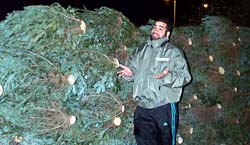 d gather himself up into the attic and lower the refrigerator-size box down. Mother and I waited below to receive the box and open our time capsule. d gather himself up into the attic and lower the refrigerator-size box down. Mother and I waited below to receive the box and open our time capsule.
This year, I took to the open road in search of my very own live tree. The average growth time for a Christmas tree is seven years. For seven years, most of the trees gracing Chesapeake Country's roadside stands and retail lots have been rising in rich soils - not necessarily local soils - tended by groomers who trim them yearly into shape.
In Severn, Bob and Barbara Hunter of Hunter's Meadow Mt. Trees have been tending to Christmas trees for 35 years. They've sprouted a sustainable farm in Garrett County, from which they harvested 1,500 trees about 50 days ago. For $6 a foot, you can choose from Fraser and Douglas firs and Colorado blue spruces. The Scotch and white pines run $4 a foot. All Hunter trees grow for up to 10 years, yeilding a seven-foot-high average tree. Information 410/255-2683.
Thirty-five years ago, my parents dished out enough for a 13-foot Douglas, instead buying the bargain, long-lived tree that dominated the only Christmas tradition I knew.
It descended the ladder sealed shut with loads of masking tape and bulging with things that I could not wait to get my hands on. It was all the stuff from years past, even to the newspaper that my brother and I poured over each year, which seemed ancient though it was but one year earlier. It was as if a lifetime went by each year, while only the keepsakes in the box stayed true.
As you read these words, someone in Chesapeake Country is buying a real Christmas tree. Some one million acres of America is devoted to growing Christmas trees, which provide the per-acre by-product of the daily oxygen requirements for 18 people. My family helped create no oxygen, just a reliable tradition.
Carefully following the nail-polish color codes at the end of each wiry branch, we shaped up our tree in no time. Certainly less time than choosing, transporting and setting up a real tree.
At Green Landing Nursery in Upper Malboro, I found a small but nice selection of balled and burlapped trees. I saw the one I wanted almost immediately, pulled my truck to a halt and made my way through the piles of cut trees laying in waiting for their owners. Short and stocky, that Canadian fir was adorable. I could relate to it, and it would be just perfect in the dining room. Alas, it had already been sold. Information 301/952-0593.
As I drove on disconsolate, what to my wandering eyes should appear but Homestead Gardens, shining bright from miles away, alight with enough twinkle lights to light the way to the north pole. I had found the mother lode of Christmas trees. Four thousand trees of all shapes and sizes waited like dogs in the pound to be chosen.
The temperature was dropping rapidly, another factor of tree shopping that my mother chose not to deal with. But plenty of helpers loitered about the makeshift forest to help me out. From them I soon learned a balled and burlapped tree should stay indoors for no more than a week. So on I went with no tree. Information 410/798-5000 · www.homesteadgardens.com.
Maybe Mas-Que Farm Christmas Tree Plantation in Annapolis, where Austrian pines round out a forest of 150 cut trees, will have the tree for me. If so, my purchase will benefit Maryland Therapeutic Riding programs. Information 410/267-8900.
Wherever I find my tree, I'll bring it home wrapped or in a closed vehicle so it doesn't dry out. Before bringing it into my Annapolis apartment, I'll make a fresh cut across the bottom so it can take up water, which I'll check every day. And I'll set it up away from heat sources and out of direct sunlight.
If I choose to cut, I'll have three weeks to enjoy my tree indoors and ornament it with my own traditions before I set my dry tree out at the curb to be picked up by Anne Arundel County and recycled into mulch. (For tree recycling in Calvert, call 800/560-1004).
But I still may choose a living tree to be planted in the future. Either way, not much shall waiver from my childhood template. I see my family gathered by the tree, basking in the glow of twinkle lights, hot chocolate in hand. Now it is my turn to fill the time capsule with memories.
To learn more about live trees, log onto the Maryland Christmas Tree Association: www.mda.state.md.us/org/mcta.htm.
Oyster Boys on the Half Shell
Under the glow of October's full moon and a dim string of white lights, Jeff 'Jefferson' Holland sets up the plot for the next folk song from his seat near the pilot house of buyboat Half Shell. Kevin 'Brother Shucker' Brooks plays light banjo for mood.
'Tis the story of vile pirate captain Richard 'Dick' Clark, renamed Captain Doubloon for the sake of good storytelling. In verse, Holland's eyes go squinty and his voice turns pirate's snarl as he sings of how a cabin boy saved Annapolis from pillage. And of how sea nettles were born of pirates' blood.
The audience smiles broadly at the yarn, their imaginations stoked. Some of t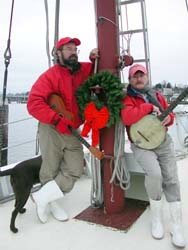 he few kids on board wonder aloud whether pirates still roam about. Holland smiles through his thick beard. he few kids on board wonder aloud whether pirates still roam about. Holland smiles through his thick beard.
This lyrical tale of Dick Clark the pirate is but one of many spawned by Them Eastport Oyster Boys, equal parts Holland and Brooks. Before the night is done, they will sing the tale of Chessie, a 42-ton Chesapeake Bay retriever with 80-knot breath and a tail that makes six-foot wakes when it wags. Sing the recipe for Mama's beaten biscuits. Sing about the three elements to a full Eastportorican life.
"We have fun celebrating where we live," says Brooks. Since the early '90s, the Oyster Boys' collaborative creativity has yielded songs ranging from a tango about sub-aquatic vegetation to a deck-shoe chantey to a reggae about sailing. They even composed Maritime Republic of Eastport's national anthem. "Eastport's an eclectic and diverse area, and the music that we do kind of reflects that, from tangos to waltzes to reggae to Dixie to rhythm and blues, the whole bit," explains Brooks.
Though musical credit is shared, Brooks yields lyrics to Holland, Poet Laureate of Eastport since 1995. "That's his fault," Brooks says.
Holland's eyes gleam through his glasses with almost childlike enthusiasm when he speaks of his muse. "Inspiration is all around," says Holland, gesturing toward Annapolis in the distance. "I'm shocked that there aren't more people doing what we do.
"Look around here. This is an incredibly inspirational place. Look up in Whitehall Bay and imagine that there's a sea monster up there. And what can a sea monster be on the Chesapeake Bay? Well, how about a Chesapeake Bay retriever? And if it was a Chesapeake Bay retriever, and it was a giant retriever, and it was a Chesapeake Bay sea monster, what would he do? Well, there's the State House dome! He'd bury it like a bone! And there's the governor's house. He'd fetch it! Like a stick! So, you look around you. And you see what there is to see. And you leave your imagination open. It's great-great-great fun."
The fun began some 10 years ago, when then-bassist Brooks joined the four-year-old quartet Crab Alley, of which Holland was an original member. A couple years later, when segmentation divided the group into duos on opposite shores of the Bay, Them Eastport Oyster Boys went larval as they explored their own original repertoire. With Brooks reassigned to six-string banjo and Holland on baritone ukulele, they took their current name and settled in as fresh spat on the reef of Annapolis' music scene.
In the highest traditions of oyster recovery, Them Eastport Oyster Boys' success helped revitalize folk music in Annapolis. Holland was crowned Poet Laureate of Eastport in 1995 and the duo's "Eastport Shuffle" was chosen as the fledgling Maritime Republic of Eastport's national anthem. The two play mostly on boats but have been tonged regularly to play local festivals and concerts. They even recruit a few friends to play along now and then, often bringing in the Horn Point Horns for bigger venues. It's all in the name of fun and local pride.
"What we're trying to accomplish is to get people to appreciate this wonderful treasure we have in our own backyard by singing about it in a way that doesn't beat people over the head with a message," says Holland. "Our message is, we're having fun here, this is a great place. Don't you love it? Don't you want to treasure it? Don't you want to restore it? It's almost a subliminal message. If we're out here having fun and singing songs, then you can have fun on the Bay, too. And in order to have fun on the Bay, you've got to take care of it."
Get an earful of Them Eastport Oyster Boys at Midnight Madness, December 7. The duo plays a concert for the debut of their second album, An Oyster Boys Christmas ($12), featuring original holiday songs, the spoken word and new spins on old favorites. 7-8pm @ Historic Annapolis Foundation Museum Store, 77 Main Street, Annapolis: 410/268-5576.
Paul Reed Smith's Dragons Roar
When a group of black-clad, cowboy-booted rockers stepped onto the O'Br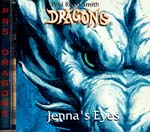 ien's music stage, they transformed the dimly lit Annapolis waterhole into a fiery dragon's lair. ien's music stage, they transformed the dimly lit Annapolis waterhole into a fiery dragon's lair.
Chesapeake Country world-class guitar-maker Paul Reed Smith and his band of Dragons had returned downtown for an infrequent two-night stand to plug their sophomore album, Jenna's Eyes. Yet the night's raw weather kept many fans at home, leaving O'Brien's near empty. Still, the high-spirited Dragons had come to play.
It took nearly a year to record, mix and master their new musical monster, and as you may expect from a man who designs guitars for Carlos Santana, PRS's album is nothing short of a down-home guitar attack.
Smith's intention to rain rock 'n' roll fire on O'Brien's was clear when he unsheathed his legendary Dragon I model guitar, the six-string Excalibur once displayed in the Smithsonian.
There are only 50 of these babies in existence, and each costs as much as a well-equipped Mercedes. When strummed in high gear, the Dragon I howls like a cherry American street rod.
With the pedal to the metal, Jenna's Eyes bursts off the line. Smith unloads a barrage of searing riffs on "Dancin's a Fine Line" and "Cold Wind in July" that, on stage, had sweat pouring from his curly mop and fogged up his spectacles.
Guitarist/vocalist Ralph Perucci responds with touch precision and speed, handling his PRS machine through curves like "Still Breakin' Hearts," and across the salt flats of "How Bad Is That." In the studio and live, Perucci - a soulful technical player - and Smith - a raw talent player - box the quintessential guitar match, with each man throwing jaw-breaking licks without ever knocking the other out.
Meanwhile, seasoned drummer Bob Mater thunders his Pearls flawlessly without sacrificing any soul. On stage, Smith, sharing in grooves like "Slicksville," would stop playing momentarily to admire Maters' moves.
Bass man/vocalist Hugh Mason stood center stage as the Dragons' axis. His presence was defined by his sound. Strong and uplifting on the album, his undertones crawl up into your belly and make you want to boogie-woogie.
No music machine is complete without a coat of vibrant color and flame decals. For this, Curt Stevens shares his pipes as a backing and lead vocalist. Smith also makes a statement vocally on tracks like "She's the One," thanks to vocal coaching from Stevens.
The band brought the tempo down, without losing steam, for songs like "Diane" and the album's title track "Jenna's Eyes." On the album, this allows you to hear the sheer brilliance and crisp perfection that is a PRS guitar.
"There is no mistaking the sound of a PRS guitar," said Scott James of WRNR. "It's bright and captivating, exactly what a guitar should sound like."
Smith's fellow musicians seem to strive for perfection as well. That value shined through brightest on their final number, a soaring arrangement of the "Star Spangled Banner," the album's closer.
Overall, Jenna's Eyes is tight, pristine and well produced. It's no exaggeration when Tom Wheeler writes in the liner notes "The CD might be described as touch sensitive: You can hear the hands on the strings."
Don't expect to see the Dragons in the area any time soon. Their next gig is in California. For you rock-n-roll fans who also follow NASCAR - and there are a lot - there's talk, according to Smith, of the Dragons performing at this year's Daytona 500.
For info on PRS guitars, log on to http://www.prsguitars.com. For the album, call PRS accessories: 410/643-9970.
In Solomons, Scouts Help Light t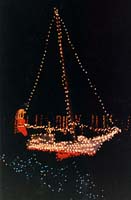 he Way to Christmas he Way to Christmas
Solomons Island, known for sailing and seafood, sets a different scene this weekend, lighting up for its 15th annual Christmas Walk with candlelit streets and a river of illuminated watercraft.
Boats will be set aglow by Christmas lights and imagination, while the island itself will bask in over 5,000 luminaries that are set to glow by local Boy Scouts.
Just before 4pm, over 50 scouts from Solomons Troop 427 will gather at Our Lady Star of the Sea Church to fill round plastic containers with two inches of water and single candles. Then the scouts will place one every 10 feet along the roadside from Grandmother's Store, north of Solomons on Dowell Road, to the University of Maryland Biological Laboratory at the far end of the island.
The scouts divide to begin their work at each end and meet up almost an hour and a half later with their work done for a few hours. When Friday evening's events end around 10pm, the scouts go back out on the route, gathering up the containers and returning them to the church so they can start all over again Saturday evening.
The traditional luminaries, with origins in Mexico, are made from waxed brown bags weighted down with sand and illuminated with a single votive candle. Before commercial holiday lights, families in Mexico would put them on top of their roofs on Christmas Eve to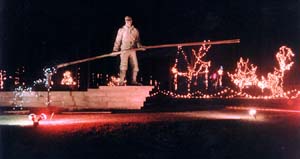 help guide Jolly Old Saint Nick. In the Southwest, traditional luminaries still light the paths to churches, homes and celebrations. help guide Jolly Old Saint Nick. In the Southwest, traditional luminaries still light the paths to churches, homes and celebrations.
Solomons' modern luminaries first lead visitors onto the island, then weave a glowing ribbon along both sides of the streets.
The only display of this magnitude for miles around, Solomons' has, since its beginning 15 years ago, been supported by the town business association and realized by local Boy Scouts.
"It's a lot of work that they do it as a service to the community," says Paul Douglass, Cub Master of Pack 427.
To the north on Dowell Road, luminaries lead to another brilliant event at Annmarie Gardens. In this outdoor garden of art, large jellyfish, flowers, deer, sailboats and even the resident oyster tonger are bathed in lights as you drive through. Dim your lights as you cruise around the wonderland, and leave a charitable donation of a non-perishable food with the volunteers at the gate to the gardens.
Last year over 30,000 cars flocked to this extraordinary display, donating enough food to fill over 15 large drums plus $6,500 in cash for holiday gift baskets for the needy.
These lights stay lit from 6 to 9pm each night until January 1.
Way Downstream ...
Washington Update: the FAA ruled last week that U.S. Airways broke no rules in allowing Charlotte, a 300-pound Vietnamese potbellied pig, to fly first class cross-country last week. The pig made headlines when Charlotte lost her composure during landing and began running about the plane ...
In Idaho, noted outdoorsman Jack Hemingway, son of the great writer Ernest and father of actress Mariel, died December 1 after complications from heart surgery. He made money writing, but was known locally as a member of the Idaho Fish and Game Commission who saved trout streams from the bulldozers of progress ...
In Madison, Wis., the Onion, a satirical newspaper, reported that a poll by the American Public Transportation Association found that 98 percent of Americans favor mass transit use: by everyone else. One driver said: "My drive to work is unbelievable. It's about time somebody did something to get some of these other cars off the road" ...
In California, that 1,000 year-old redwood tree in which Julia 'Butterfly' Hill resided for two years to protest old-growth logging was attacked by a chainsaw over the weekend and may not survive ...
Our Creature Feature comes from Maine, where a boom in the lobster population is mystifying researchers. When cod and other fisheries collapsed in the '80s and '90s, many fishermen turned their attention to lobster, leading scientists to worry that the lobster fishery would crash, too.
But strangely, the lobster population has tripled since the 1980s, leaving experts scratching their heads. Some say it's warmer waters from global warming. Others say with fewer fish, lobsters have more to eat. Still others say there was a hidden cache of lobsters offshore. Whatever the reason, Maryland watermen are hoping for such a mystery for crabs.
Copyright 2000
Bay Weekly
|